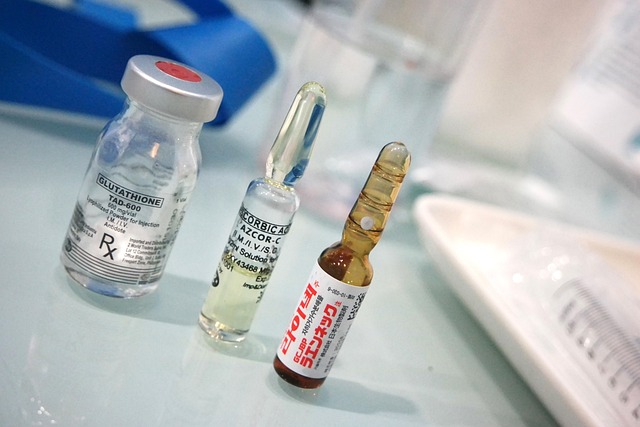Semaglutide, a novel GLP-1 receptor agonist, offers a game-changing approach to type 2 diabetes management with its once-weekly injectable formulation. This long-acting form provides sustained blood glucose control, mimicking natural GLP-1 hormone actions. Dose adjustments are individualized based on patient responses, including blood glucose levels, weight, and tolerability, starting from low doses (0.25 mg or 0.5 mg) weekly under medical supervision. Regular follow-ups are vital for dynamic dosing adjustments, aiming to balance efficacy and safety. Healthcare providers tailor treatment plans, monitoring symptoms, side effects, and HbA1c levels during titration to optimize glycemic control while minimizing adverse reactions.
“Discover optimal dosing strategies with semaglutide injectable formulations. This comprehensive guide explores dose adjustment protocols, offering insights into initial settings, response monitoring, and titration techniques. From understanding semaglutide’s unique properties to handling individualized adjustments, we cover best practices for effective injections and enhanced patient compliance. Learn how to navigate factors influencing doses and ensure optimal outcomes in clinical settings.”
Understanding Semaglutide and its Injectable Formulation

Semaglutide, a novel glucagon-like peptide-1 (GLP-1) receptor agonist, has gained significant attention in diabetes management due to its unique pharmacological profile. Its injectable formulation offers a once-weekly administration option, setting it apart from traditional daily insulin injections. This long-acting semaglutide form allows for sustained control of blood glucose levels, making it an effective treatment for type 2 diabetes patients. The medication mimics the natural hormone GLP-1, which stimulates insulin release and suppresses glucagon secretion in a glucose-dependent manner.
The semaglutide injectable formulation is carefully designed to ensure optimal efficacy and safety. It typically comes in pre-filled pens or vials, providing healthcare professionals with convenient administration tools. Dose adjustment protocols for this medication involve careful monitoring of patient responses, considering factors such as blood glucose levels, weight, and individual tolerability. Healthcare providers adjust the dosage to achieve the desired glycemic control while minimising adverse effects, ensuring an effective and personalised treatment approach.
Initial Dose Settings for Semaglutide Injections

When initiating treatment with semaglutide in its injectable form, careful consideration is crucial to set the initial dose appropriately. The starting dose should be based on individual patient factors such as age, weight, and medical history. Typically, healthcare providers recommend a low initial dose of 0.25 mg or 0.5 mg, administered subcutaneously once weekly. This cautious approach allows for careful monitoring of the patient’s response, enabling adjustments to better manage potential side effects while optimising therapeutic outcomes.
The goal is to find the optimal balance between efficacy and safety. As patients tolerate the medication, subsequent doses can be incrementally increased under medical supervision, usually by 0.25 mg or 0.5 mg per week until the desired effect is achieved. Regular follow-ups facilitate a dynamic adjustment process, catering to each patient’s unique needs and ensuring they receive the most effective treatment with minimal adverse reactions.
Factors Influencing Dose Adjustments

Several factors play a pivotal role in determining dose adjustments for injection, especially with medications like semaglutide in its injectable form. One of the key considerations is the patient’s individual response to the treatment. Every patient metabolises and responds to drugs differently, influenced by their overall health, age, weight, and other medications they might be taking. Therefore, a tailored approach is essential, where healthcare providers monitor patients closely and adjust doses accordingly to ensure optimal efficacy with minimal side effects.
Another significant factor is the specific type and stage of the condition being treated. For instance, in diabetes management, semaglutide’s dose may vary based on blood sugar control goals. Additionally, patient compliance and preferences matter; convenient injection schedules and acceptable dosing volumes can enhance adherence to treatment protocols. Understanding these variables allows healthcare professionals to personalise therapy, making it more effective and user-friendly for each individual.
Monitoring Patient Response to Dose Changes

When adjusting doses for injection drugs like semaglutide, actively monitoring patient response is paramount. This involves regular check-ins with healthcare providers to assess symptoms, side effects, and blood glucose levels. The semaglutide injectable form, known for its once-weekly administration, requires careful observation during dose titration to ensure optimal glycemic control without excessive adverse reactions.
Healthcare professionals should educate patients on recognizing key responses—both positive and negative—to guide future adjustments. This collaborative monitoring ensures a personalized approach, fine-tuning the dosage to individual needs. By staying attuned to patient feedback and clinical markers, healthcare providers can navigate dose changes effectively, enhancing treatment outcomes for diabetes management using semaglutide.
Common Protocols for Titrating Semaglutide Dosage

Semaglutide, in its injectable form, is a medication used for type 2 diabetes management and weight loss. Dose adjustment protocols are crucial to ensure optimal efficacy and minimize adverse effects. Common protocols for titrating semaglutide dosage involve starting with a low dose and gradually increasing it over time. This approach allows the body to adapt to the drug’s effects, reducing the risk of nausea or other gastrointestinal issues that may occur at higher doses.
The initial dose is typically around 0.25 mg once weekly, given subcutaneously. After a few weeks, depending on patient response and tolerability, the dosage can be increased to 0.5 mg or 1.0 mg per week. Healthcare providers closely monitor patients’ blood sugar levels (HbA1c) and assess their overall tolerance during this titration period. Regular follow-ups are essential to make informed decisions about further dose adjustments.
Handling Individualized Dose Adjustment Scenarios

When it comes to handling individualized dose adjustment scenarios for semaglutide injectable forms, healthcare providers must be adept at tailoring treatment plans based on patient-specific factors. This includes evaluating the patient’s medical history, current health status, and previous responses to therapy. For instance, patients with a history of nausea or gastrointestinal issues might require lower initial doses, gradually increasing as their bodies acclimate.
In these cases, close monitoring is crucial. Regular follow-up appointments allow for the assessment of symptom management, blood glucose levels, and overall well-being. Based on these observations, healthcare providers can make informed decisions about further dose adjustments, ensuring optimal efficacy while minimising adverse reactions. This personalised approach maximises patient comfort and adherence to treatment protocols.
Best Practices for Effective Injection and Compliance

Maintaining optimal dosing protocols for injection is crucial for achieving effective treatment outcomes, especially with medications like semaglutide in its injectable form. Best practices involve strict adherence to prescribed schedules and dosages. Patients should be educated on proper administration techniques, including understanding the appropriate depth of injection, which varies based on the body area chosen. This knowledge empowers them to ensure each dose is accurately administered, enhancing compliance and treatment efficacy.
Regular follow-up appointments play a vital role in monitoring patients’ progress and adjusting semaglutide doses as needed. Healthcare providers should encourage open communication, allowing patients to voice any concerns or side effects promptly. By combining patient education with close medical supervision, healthcare professionals can optimize injection protocols, ensuring the best possible outcomes for patients receiving semaglutide treatment.
